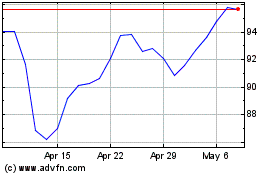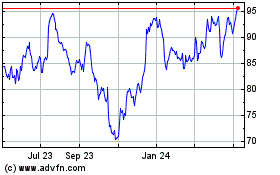BHP Billiton's Iron Ore Production Shows No Signs of Slowing
July 19 2016 - 11:20PM
Dow Jones News
SYDNEY—BHP Billiton Ltd. will tip more iron ore into the global
market in the year ahead, as miners show few signs of holding back
output of the commodity despite a worsening glut.
Iron-ore prices have been dragged to a decade low as large
exporters churn out rising volumes of the raw material intended to
feed growth in China that is now slowing down. It is leading to
mushrooming stockpiles of the raw material, the main ingredient in
steel needed for everything from cars to skyscrapers, that could
take years to clear.
On Wednesday, BHP forecast its vast network of iron-ore mines in
remote northwest Australia, the source of much of the global trade
in the commodity, could produce up to 7% more in the year ahead
versus the prior 12 months.
The miner, the world's biggest by market value, said it produced
a record 257 million metric tons of iron ore from its Australian
pits in the year through June, aided by the ramp up of its newest
operation, Jimblebar. BHP projected output of between 265 million
and 275 million tons in its current fiscal year.
Analysts have speculated whether the world's big iron-ore
producers would start to tap the brakes after watching their
earnings shrink on tumbling prices.
Iron-ore prices have fallen to around US$50 a ton from more than
US$190 a ton as recently as 2011, as supplies from new and expanded
mines planned when prices were booming began to outpace demand. BHP
reported an average price of US$43 a ton for the last financial
year, down 30% on the 12 months prior.
In February, Rio Tinto and BHP, the world's No. 2 and No. 3
exporters of iron ore, both of which rely heavily on iron ore for
earnings, abandoned respective pledges to keep dividends steady or
rising as each reported large losses.
Global iron-ore miners have repeatedly defended iron-ore
production increases, despite the rapid downturn in prices.
Their strategy is to produce as much ore as possible for the
lowest cost, rather than extract less in the hopes of bolstering
prices. Thanks to economies of scale, they still generate a healthy
margin on each ton they ship, even with prices falling.
BHP did produce slightly less iron ore than anticipated over the
past year—even after downgrading its output estimates earlier in
2016—because its Australian operations were disrupted by bad
weather and the start of a rail maintenance program. The suspension
of operations run by its Brazilian joint venture with Vale after a
catastrophic dam burst in November also weighed on global
sales.
Earlier this year, Rio Tinto too trimmed a projection for output
for 2017, although only after delays to an autonomous railway
system it is trying to roll out across its train network in
Australia's iron-rich Pilbara mining region.
Rio Tinto, which on Tuesday reported a 7% on-quarter jump in
Australian iron-ore shipments, still says output from its mines
here should increase both this year and next.
Vale SA, the world's top supplier of the commodity, has also
been increasing its production of the commodity and is racing to
complete a US$14.3 billion iron-ore mine in the Brazilian Amazon.
Meantime, Australian billionaire Gina Rinehart's new
55-million-ton-a-year Roy Hill mine in the Pilbara is ramping up,
as is Anglo American PLC's Brazilian Minas Rio project.
Morgan Stanley forecasts an oversupply in the seaborne iron-ore
market to increase to 89 million tons in 2017 from roughly 60
million this year. It projects the market, which was in balance as
recently as last year, will remain oversupplied for at least the
rest of this decade.
BHP said it would increase its own production of the commodity
by working its operations harder. "Over the next 12 months, we
expect volumes and costs across our minerals businesses to benefit
from our continued drive to safely improve productivity," Chief
Executive Andrew Mackenzie said in a statement.
BHP said its Australian iron-ore mines were already running at
an annualized rate of 275 million tons in June. Steps to improve
productivity and further ramp up Jimblebar should increase capacity
to 290 million tons in its 2019 fiscal year, the company said.
The miner didn't provide forecasts for the Brazilian joint
venture, Samarco, which is unlikely to restart operations in 2016.
BHP also said it couldn't yet estimate the final financial cost of
the dam failure, which killed 19 people and polluted hundreds of
miles of rivers in Brazil.
Write to Rhiannon Hoyle at rhiannon.hoyle@wsj.com
(END) Dow Jones Newswires
July 19, 2016 23:05 ET (03:05 GMT)
Copyright (c) 2016 Dow Jones & Company, Inc.
Morgan Stanley (NYSE:MS)
Historical Stock Chart
From Mar 2024 to Apr 2024

Morgan Stanley (NYSE:MS)
Historical Stock Chart
From Apr 2023 to Apr 2024
